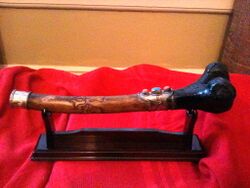Biology:Kangling
Kangling (Tibetan: རྐང་གླིང་།, Wylie: rkang-gling), literally translated as "leg" (kang) "flute" (ling), is the Tibetan name for a trumpet or horn made out of a human tibia[1] or femur, used in Tibetan Buddhism for various chöd rituals as well as funerals performed by a chöpa. The leg bone of a deceased person is used.[2] Alternatively, the leg bone of a respected teacher may be used.[3] The kangling may also be made out of wood.
The kangling should only be used in chöd rituals performed outdoors with the chöd damaru and bell.[2] In Tantric chöd practice, the practitioner, motivated by compassion, plays the kangling as a gesture of fearlessness, to summon hungry spirits and demons so that she or he may satisfy their hunger and thereby relieve their sufferings. It is also played as a way of "cutting off of the ego."[citation needed]

A minor figure from Katok Monastery, the First Chonyi Gyatso, Chopa Lugu (17th – mid-18th century), is remembered for his "nightly bellowing of bone-trumpet [kangling] and shouting of phet" on pilgrimage, much to the irritation of the business traveler who accompanied him. Chopa Lugu became renowned as "The Chod Yogi Who Split a Cliff in China (rgya nag brag bcad gcod pa)."[4]
See also
- Gyaling
References
- ↑ Attala, Luci; Steel, Louise (2019-05-01) (in en). Body Matters: Exploring the Materiality of the Human Body. Cardiff, Wales: University of Wales Press. pp. 166. ISBN 978-1-78683-416-4. https://books.google.com/books?id=jDiqDwAAQBAJ&pg=PA166.
- ↑ 2.0 2.1 O.C. Handa (2005). Buddhist Monasteries of Himachal. Indus Publishing Company. pp. 320. ISBN 81-7387-170-1.
- ↑ Andrea Loseries-Leick (2008). Tibetan Mahayoga Tantra: An Ethno Historical Study of Skulls, Bones and Relics. B.R. Pub. Corp. pp. 225.
- ↑ Chhosphel, Samten (December 2011). "The First Chonyi Gyatso, Chopa Lugu". The Treasury of Lives: Biographies of Himalayan Religious Masters. http://www.treasuryoflives.org/biographies/view/Chopa-Lugu/8631. Retrieved 2013-10-08.
 |



